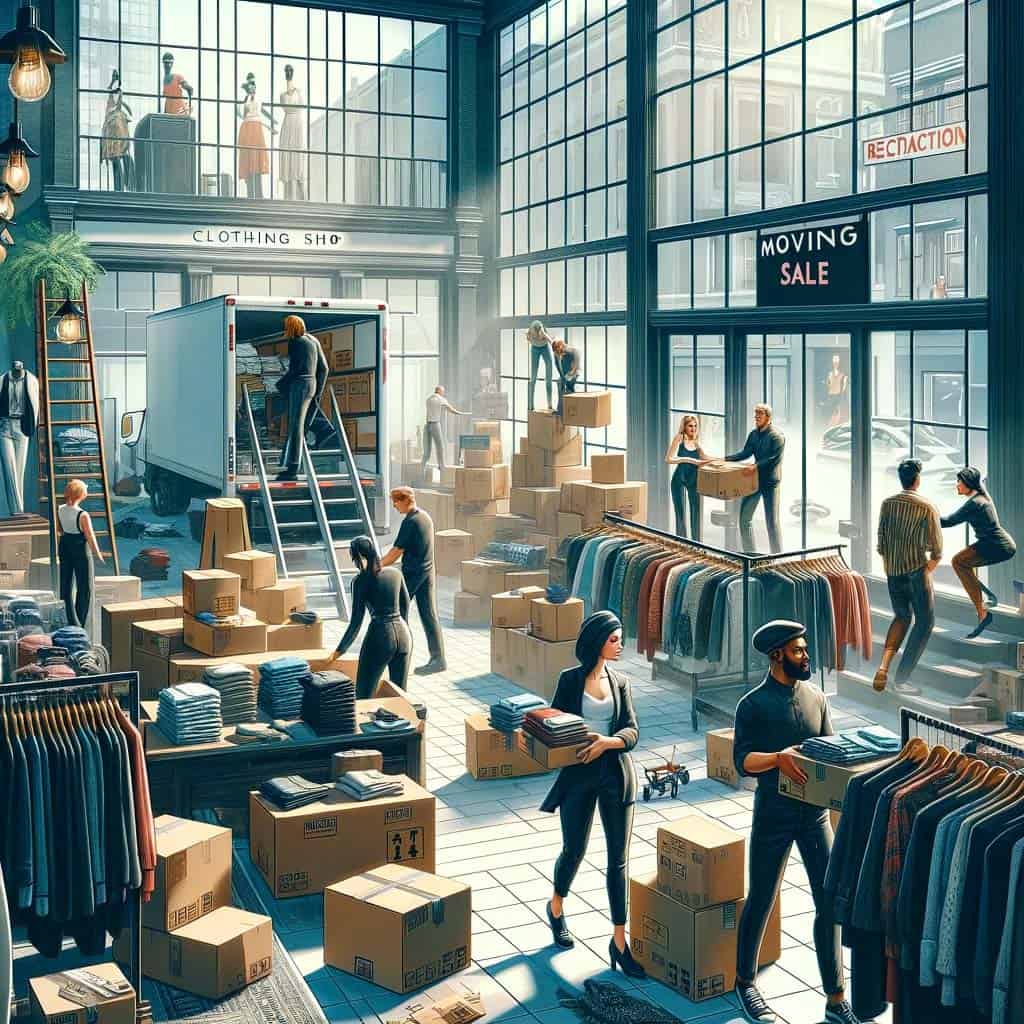
As professional shop movers, the professionals at Ferguson Moving & Storage understand that moving any retail space is quite different than moving a home. With a clothing store, there is also more to consider than just moving the clothing and even that is going to be different than the advice we give to homeowners. Vancouver store movers know that there will be operational equipment, furnishings and fixtures that need to be disassembled with the right tools, or handled with care.
And, retail supplies are not like ordinary furniture. If retail store movers don’t do their job correctly, any broken or missing pieces of a store can affect revenue at worst, and result in a mismanaged, frustrating store to shop in, at best. But, sometimes moving to a new commercial retail space is necessary, either to downsize your costs or grow the traffic needed in your store.
With that in mind, we’ll give you some tips on relocating a retail shop. Even if you plan on hiring professional store movers to do the job for you, it’s good to be equipped with the knowledge you’ll need to know if they’re doing a good job.
Thoroughly discuss moving rates, ask questions and plan for the unpredictable level of inventory to move.
When you get an in-person estimate to move a clothing retail store, one question that will come up is: how much inventory are we moving? Let’s say your store is moving in two months. You’ll be getting deliveries or supplies in that time, to keep the store stocked. Or will you? What if you aim for liquidation, but don’t know how much you’ll realistically sell by moving day?
Since the inventory levels that need to be moved can be hard to predict, it’s crucial you discuss this with your professional movers in advance.
Another MAJOR consideration is for international movement of goods. If you’re planning on moving across borders, there may be customs documentation needed. Bring this up with your mover, especially in case they’re not aware, or forget to ask you about it. This page of the Canadian government’s website has more info: https://www.cbsa-asfc.gc.ca/comm-eng.html Find out your costs, and what may happen if your movers are delayed or rejected at the border for any reason – who pays in that instance?
The next question to ask is about tear-down. You may have wall racks attached to studs, light fixtures (like chandeliers), cabinetry, wall divisions and other more-or-less ‘permanent’ materials in place for your store’s ‘look and feel.’ The store mover may not be thinking that the ‘semi-permanent’ parts are their job too. But if you need them to be, let them know! Sometimes, these can be thought of as part of renovation or junk removal services.
If this is your first time moving a clothing retail store, remember that movers are not like delivery companies. They are also not moving anything similar to your home. So these differences in your past experiences will need to factor in to your expectations.
On that note, we also recommend checking for moving insurance!
Prepare far in advance of the store movers’ arrival.
While technically you could ask Vancouver store movers to handle everything about your move, chances are you’ll want to take care of much of this yourself.
First of all: consider labour costs. Your minimum wage employees may be the perfect cost saving alternative to boxing up your store. This is especially true of your store experiences down time with little traffic, and your store employees would otherwise only be holding down countertops for you.
They’re also trained to use your equipment and know how your store is already organized. So they’re going to be the most knowledgeable when it comes to keeping the right things together in the right boxes.
Other professional tips from your shop movers:
- Have your packing tape, foam, boxes etc. ready for employees to start packing. Don’t let wasted time go by because they didn’t have the equipment to do the job. When you shop for these, you may also want to get some large paper rolls to hide what’s going on inside your store windows on moving day – though this up to you.
- Take down mannequins and disassemble them if they’re not being used. Put them in boxes – either together with their individual parts, or ‘arms with arms, legs with legs,’ etc.
- Find all your admin stuff – receipt rolls, price stickers, tagging guns and even your pens. Your extras may be stashed away somewhere that you forgot about. Gather them all together so they’re not loose ends that need to be cleaned up, wasting time, on the day of the move.
- Hire your cleaners, or arrange for employees to do this task. Don’t forget to empty the steamer and vacuum. Best to have the dusting done before you pack up shelves and racks.
- Check your lease rules to see if moving docks, backdoor access ways, delivery parking spots, or even allowed hours for moving are going to fit in with your store movers’ schedule.
- Make sure your moving company will have all the equipment needed for a clothing retail store move. For example, do they have the right types of moving dollies for your needs? What about ramps on their trucks if they can’t use loading docks? Clothing racks and protections? Ask about everything!
- If you have an alarm or security equipment managed by a third-party company, schedule them to come in on the same day of the move. They’ll need to re-install your systems and set you up at the new location.
- Contact any utility companies to make arrangements for the move. Water hookups, electricity, phone lines, Internet etc. will all need to be operational when you are open for business at the new location. Do your address changes for other services where necessary (such as with credit card companies, banks, etc.)
- Clear out personal items such as employee mugs, lockers, and whatever else may be hanging around.
- Schedule your bank deposits from your cash register and POS system the night before, so that you’re not carrying large monetary amounts to the new store. You don’t want this to go missing during the commotion of the move.
- If you hire a display designer, make sure they’re available to set up your store when you move. And if you’re using their staging supplies, you may want to have them pick that up on moving day, to avoid being responsible for any damages.
- Find out how you’re going to take down signage, and if it can fit in your new space. You may need specialists to handle this part of the move. Same goes for vinyl wall or window decals.
We also recommend making it known on your website, and with a store sign, that you are moving, and what the new address will be. See our article linked-to below about how to preserve your SEO when moving a business, for more on this.
Sell whatever clothing inventory you can.
Depending on how far you’re moving, your budget, and the markup on your inventory, it may be worth holding a massive sale before moving. That said, the case here can be different for different clothing stores. You may want to do a bit of math to find out if offloading your inventory is cheaper than paying to move it professionally.
Selling off inventory doesn’t just have to mean putting on a sale. You can also donate to local charities, as another option for getting rid of inventory. See this article on our blog for options.
Protect your inventory when moving a shop to a new location.
It goes without saying that you’re going to need to take extra precautions to make sure your inventory is still sellable after you move to a new store location.
You may not have all the original packaging that your store’s clothes came in. But it may be a good idea to start collecting the plastic bags and boxes they’re being delivered in, so they can be re-boxed the same way for the move. You can also ask your suppliers for extras.
When you do pack the clothing, we do not recommend you use for-sale materials to cushion your breakables. We can give this advice to homeowners, but this is a different case. You want to keep your clothes looking as new and unused as possible. If you pack brochure displays or detachable hooks with your clothes, they might tear, and you don’t want that.
And, don’t forget about the breakables, like accessories. Do you sell nail polish and jewelry? How will you keep them from damage during the move?
When everything is boxed up, you may want to also consider humidity and moisture. If you’re moving dresses on rolling racks – even if they’re bagged in plastic – you want to keep the bottom away from puddles. You also want to make sure that the moving truck isn’t packed so that a water-filled steamer or cleaning spray bottle is sitting adjacent to clothing. Best to treat the clothing as fragile in this case, and let your movers know about the concern too.
Moving a clothing retail store doesn’t have to be difficult. But it does help to know the differences from when you’re moving a house. This can prepare you for the smoothest transition to your new space. And, by discussing these considerations in advance with your store movers, you’ll likely save money, or at least come to a more accurate estimate.
Ferguson Moving & Storage can help with your retail moving needs. Give us a call, and we’ll come by for an in-person estimate.
See related:

Categories
Moving Resources
Moving Checklist
Follow this comprehensive moving checklist to ease your relocation stress and stay organized.
Learn MoreMoving Company Comparison Guide
This comparison guide helps you evaluate and select the perfect moving company for your needs.
Learn MoreWe make moves easy for you.
- Local Moving
- Long Distance Moving
- Seniors Moving
- Piano Moving
- Item Relocation
- Overnight and Long-term Storage
- Packing Supplies

